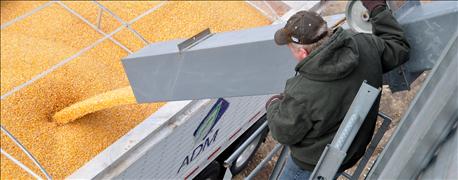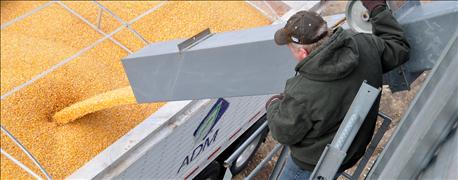
In its quarterly stocks report in late September, USDA said there were 1.738 billion bushels of corn and 197 million bushels of soybeans stored on farms or in commercial elevators on Sept. 1, which is slightly more than a year ago for each crop.
Those numbers were in addition to the huge wheat stocks of nearly 2.53 billion bushels, which were up 21% from last year’s nearly 2.1 billion.
“The numbers for corn and soybeans were in line with my expectations, but the wheat stocks estimate is bearish, suggesting less wheat was fed than expected over the summer, despite cheap prices and abundant supplies,” said Bryce Knorr, Farm Futures senior grain analyst, after the Sept. 30 report.

STOCKS: “The numbers for corn and soybeans were in line with my expectations, but the wheat stocks estimate is bearish, suggesting less wheat was fed than expected over the summer, despite cheap prices and abundant supplies,” said Bryce Knorr, Farm Futures senior grain analyst, after USDA's Sept. 30 stocks report.
Also on Sept. 30, USDA lowered 2016 wheat production slightly to 2.31 billion bushels from its previous forecast, but the crop is still up 12% from 2015. The downward revision was due to decreases in soft red winter and spring wheat production, which more than offset the increases in hard red winter and white winter wheat.
“With the reports out of the way, the market can focus on harvest weather, which is far from ideal and likely lowering yields for both corn and soybeans,” said Knorr.
The yield reductions will not be known until possibly USDA’s last monthly production estimates in January, he said.
River handles high water
Barge traffic on the Mississippi River was held up for a few days in late September as high water flowed downstream from the western Midwest, where abundant rain and flooding filled creeks and streams.
There were concerns the runoff would raise river levels so high that locks would close and barge traffic would be disrupted. In the end, only one Mississippi River lock south of the Quad Cities was closed for a few days, and barge traffic resumed fairly quickly.
The delay was more of an inconvenience than a hardship for exporters. There was enough corn and soybeans at Gulf export points to satisfy shipper needs. Basis bids at the Gulf had declined for both crops prior to the high water. By early October, grain dealers said corn and soybean processors had better cash bids than the river markets.
In early October, corn at the Gulf was bid about 38 cents over December for October shipment compared with 50 cents over the prior week. Soybeans for October shipment were bid 57 cents over November versus about 67 cents over the prior week
Crop exports have been robust, with year-to-date export shipments of corn, soybeans and wheat ahead of a year ago as of late September. Corn shipments were up 77% from a year ago, soybeans were up 36%, and wheat was up 26%.
Wheat falling out of favor in Kansas
Low prices and a late soybean harvest may cut planted wheat acreage in Kansas 3% to 5% this fall, which could result in the state’s fewest wheat acres in more than 100 years, says Kansas Wheat Commission CEO Justin Gilpin.
Wheat has not been as profitable for farmers as other crops, and current prices continue that trend. In early October, when the state’s farmers were planting next year’s winter wheat, corn in the southwest Kansas city of Garden City was bringing $2.98 a bushel, compared with wheat’s $2.75.
“The planting intentions are going to be a little bit lower this year because of where we are on cash prices,” says Gilpin. “The price being as low as it is, there is less enthusiasm to plant wheat. Also, there will be less double-crop acres because of the delayed soybean harvest.”
The soybean harvest has been slowed by rain this fall. In addition, farmers have shifted some of their traditional wheat acreage to dryland corn.
“The state of Kansas planted 8.5 million [wheat] acres last year,” Gilpin says. “If we would go down that 3% to 5% to 8 million or 8.1 million, that would be the least amount planted in Kansas in over 100 years.”
In the 1990s, the state’s wheat acreage was about 12 million; 10 years later it was about 10 million, and 10 years after that, less than 10 million. Dryland corn has claimed many of the former wheat acres.
“A change in genetics has allowed corn to be planted in western Kansas. Twenty years ago, that could not have been done,” Gilpin explains.
The rain-delayed soybean harvest also will prevent double-cropping winter wheat to soybean acreage. As of Oct. 2, the state’s soybean harvest was about 5 percentage points behind the 2015 pace and 6 points behind the five-year average.
The wheat that was planted this fall should do well, as regular rain showers this summer and fall produced ample soil moisture that will aid early growth before winter dormancy. As of Oct. 2, the state’s topsoil moisture was rated 9% surplus, 77% adequate, 10% short and 4% very short.
Despite the yearly decline in acreage, Kansas appears to have more wheat than it can use. Last year’s harvest of 467.4 million bushels was the largest since 2003 because of a 20-bushel rise in yield to 57 bushels per acre. Piles of the grain still dotted the landscape in early October, more than three months after harvest, notes Gilpin.
It was assumed this year’s low prices would make wheat an attractive feed for cattle in Kansas’ huge cattle feeding industry. But that did not happen, as the feedlots favored corn. That is part of the reason why Kansas had 533.1 million bushels of wheat in storage then — 41% more than a year earlier.
This year’s low U.S. wheat prices have helped the country’s exports despite big crops around the world. Wheat export shipments during the four-month span from June to September are up 26% from a year ago, and USDA expects yearly exports to be up 22.6%.
Burgdorfer writes for Farm Futures.
About the Author(s)
You May Also Like




